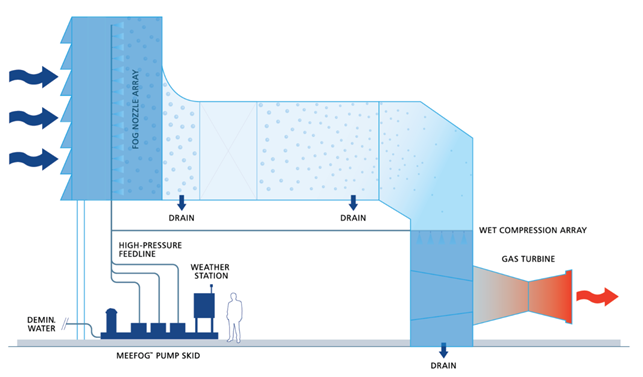How to provide peak power at 8% of the cost of a new peaking plant?
Samra Electric Power Company (SEPCO), a power utility in Jordan, has indicated the power grid has had difficulty covering peak loads observed during high temperature periods. As a result, SEPCO reviewed potential solutions for its Samra Power Plant to increase power plant generation during these peak periods. SEPCO’s intent was to modify the gas turbines by installing a fogging system in the gas turbine inlet to increase plant power generation during high-temperature periods. K&M Advisors was engaged to evaluate the technical and commercial viability of the fogging system installation. The primary aim of the evaluation was to review the design of generating units’ and auxiliary equipment and systems to determine their ability to support the increased power output during fogging system operation.
Gas turbine inlet air fogging consists of spraying water droplets into the inlet airflow of the gas turbine cooling the air by evaporation. When the fogging system is operated, the mass flow of the working fluid (air) increases through the gas turbine due to the water evaporation in the gas turbine inlet and decrease in the inlet air temperature. The increased mass flow causes an increase in gas turbine power output as the gas turbine compressor is more efficient at lower air temperatures. In addition to gas turbine power output, the implementation of a fogging system increases HRSG steam generation and in turn an increase in steam turbine output and exhaust steam flow. This increase in steam turbine output impacts the Air-Cooled Condenser (ACC) operation.
To assess the adequacy of the auxiliary systems when implementing the fogging system, K&M first developed GateCycle models of combined cycle plants. Using these models, K&M calculated heat and material balances for different ambient temperatures without and with the fogging system. For each combination of the ambient temperature and fogging system status, K&M developed a spreadsheet summarizing the system power output and power output increase, heat rate and heat rate change, fogging system evaporation rate/demineralized water requirements, and other steam and water parameters impacting operation of HRSG, steam turbine, ACC, and other auxiliary equipment that could be impacted by the fogging system. In addition to the mechanical equipment, all electrical equipment on the power generation side was also evaluated for potential impacts.
The overall conclusion of the study is that each phase of the plant experiences an increase of approximately 7-8% power output with the fogging system active which is a substantial output increase to the grid. The mechanical and electrical equipment for each phase of the plant was evaluated and verified to be capable of handling implementation of the fogging system. The major impact to current plant operation when implementing the fogging system is the water usage required for operation. The demineralizer system was analyzed to calculate the water requirements for the fogging operation for two modes of plant operation (non-cycling and cycling). The conclusion of this analysis is that the existing demineralizer system requires a combination of modifications to the demin water storage tanks, transfer pumps, and distribution piping to increase the capacity of the demin system to supply the fogging system. An alternative option is to add demin water production capacity along with additional storage. The additional water required also impacts the waste water capacity and could create an impact to the waste water treatment system.
As the procurement of the system developed, quotes were received for the fogging system installation, and it was determined that adding the fogging system is a very cost-effective way of getting peak power as compared to the construction of a peaking plant to handle peak loads. The total cost of modifying the gas turbine air inlet with the fogging system and additional demineralized water storage and pumping equipment is approximately 8% of the total cost of a new peaking plant with minimal impact to the existing plant. As a result of this comprehensive evaluation of all relevant equipment and systems along with the cost comparison of a fogging system against a new peaking plant, K&M recommended implementation of the fogging system for all four phases of the Samra plant.




